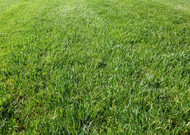Lawn Fertiliser – all you need to know.
Using a fertiliser is a great way to ensure that your grass receives the essential nutrients it needs to remain healthy, lush and green.
Using a good quality lawn fertiliser will improve the health and appearance of your lawn. It will keep your grass in good condition and help it to recover from any wear and tear. It stops it becoming patchy or thin and less likely to succumb to moss and weeds.
What fertiliser should you use?
We recommend you opt for a mineral-based mixture comprising nitrogen (N), Phosphorous (P) and potassium (K). You will see three numbers, for example, 15-5-15. This is the percentage of NPK, in this case the numbers mean that 15% of the bag's weight is made up of nitrogen, 5% is phosphorous, and 15% is potassium. In total, 35% of the bag's weight comes from these three main ingredients. The rest is filler.
There are many different types of fertiliser on the market, all with different NPK percentages and they are available in granular or liquid forms. Granular fertilisers are popular amongst gardeners because they easy to apply. Liquid fertilisers provide a quick effective way to introduce nutrients rapidly to grassroots. However, getting the quantity right can be tricky and is often best left to the professional landscaper.
The type of fertiliser you should choose will depend upon the condition of your grass, any problem areas and your budget. Some fertilisers double up as moss killer which is ideal if your lawn is plagued with moss.
You can choose between a time-release fertiliser which ‘feeds’ your lawn over many months and negates the need to remember to feed again at a certain time. A gradual release fertiliser allows plant roots to take on the required nutrients slowly, preventing necessary elements from leaching into the soil.
When to use fertiliser?
Lawn professionals will recommend feeding your lawn on a regular basis four times a year. Once in early spring (March/April), twice between May and July and once in late autumn (September to November).
The different proportions of nutrients in fertilisers are designed for use at different times of the year. More Nitrogen is required in the spring to encourage growth and a strong green colour, and more potassium in the autumn to improve the hardiness of the grass plants.
You can also buy winter fertilisers which will improve the quality of your lawn during the colder months. These fertilisers generally have a low nitrogen content.
Apply your fertiliser immediately after mowing as this will give the grass more time to absorb the nutrients before the next mow.
Remember fertiliser will not work on dry grass. There needs to be moisture in the soil for the grass roots to be able to take in the nutrients. It can also scorch or burn the grass, leaving it black and unsightly.
We strongly advise that you read the instructions to ensure you water correctly after application to ensure correct absorption.
How to spread your lawn fertiliser?
It is vital that you use the correct amount of fertiliser. Too much can scorch your grass, too little will not give you the results you are looking for.
We would advise you use a spreader as they spread the fertiliser evenly which gives better results than spreading by hand.
Handheld spreaders are good for gardens that are not a standard rectangle shape and are very easy to use. However, a mechanical push-along spreader is better for large gardens where you have a larger quantity of fertiliser to spread.
Rotary spreaders have a spinning mechanism that ‘throws’ or sprays the fertiliser while drop fertilisers have small holes in the underside out of which the feed ‘drops’ onto the grass. What you choose comes down to your preference. All are equally popular.

